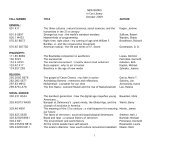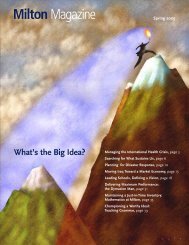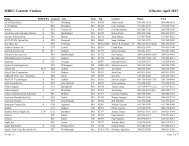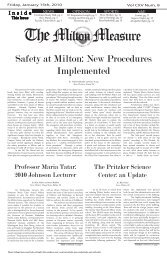Spring 2007 - Milton Academy
Spring 2007 - Milton Academy
Spring 2007 - Milton Academy
- No tags were found...
You also want an ePaper? Increase the reach of your titles
YUMPU automatically turns print PDFs into web optimized ePapers that Google loves.
Alumni AuthorRecently Published WorkCell of Cells:The Global Race toCapture and Controlthe Stem CellBy Cynthia Fox ’79The three-word title of this timelybook by Cynthia Fox ’79 capturesthe essence of stem cells;that is, a stem cell is just a singlecell but it also might, under theright conditions, give rise to celldynasties, an extraordinary featthat normal differentiated cellsof vertebrates seem unable toaccomplish.Within over 400 pages ofexplanatory text (and supportedby detailed sourcing notes at theend of the book), Cynthia treatsthe reader to the personalities,politics and places involved insome major stem-cell advancesin the past half decade. Based onher end notes, it appears that shetraveled the world to speak toleading researchers in locationsincluding Egypt, Israel, SouthKorea, Singapore, Australia,Japan and the United States.Cynthia weaves together notesfrom those interviews with storiestaken from newspapers, scientificjournals, conversationswith stem-cell recipient patients,and politicians, creating a type ofscientific whodunit. She takesthe reader on the cloning rollercoasterof successes and setbacks,describing this globalscientific race as it has unfoldedso far.She does not just list what weknow (or believe we know) todayabout stem cells; instead, shetraces growth of our knowledgethrough a series of laborious butcreative and intriguing experimentsconducted around theworld from about 1998 to 2006.She clarifies motivations, separatesgenuine breakthroughsfrom deceits, and identifies psychologicalas well as political andfinancial restraints to progress inlocating and understanding stemcells of all types. For example,even after the first normal adultstem cell (a blood stem cell) wassuccessfully cultured (in 1988, inmice), continuing psychologicalconstraints delayed discoveringadult neural stem cells. Shewrites, “…the vast majority [of scientists]believed the adult braincould not contain stem cells. Ifthe brain were constantly replacingneurons, where would thememory go?” Once the shockingdiscovery of neural (brain) stemcells was reported (in 1992, inmice), scientists began to lookmore carefully for stem cells inall types of tissues, includingcancerous tissues.Cynthia also points to the roleof politics that has encouragedglobalization of embryonic stemcellresearch. In Chapter 1, titled“Unmade in America,” shedescribes how religious beliefsof President Bush have drivenresearch on human embryonicstem cells to other countries andgreatly slowed American progressin learning how to culture and toinduce differentiation in thesetotipotent cells.When human embryos developnaturally, the stem cells “know”what to do to produce all of theessential tissues and organs,from heart to kidney to skin topancreas. Outside of a body, or inlaboratory culture dishes, howcan we tell these very same cellsto do what we would like them todo? For example, how do wecommunicate chemically to stemcells to say, “Become functionalpancreas cells, please”? This isa hugely challenging question,but one whose answer holds somuch promise for millions ofhumans suffering from diabetes,neurological disorders, cardiovascularproblems, cancer, or,literally, degeneration of anybody part.Later in her book, Cynthia walksthe reader through state-of-theartblood cancer treatments andkidney transplantations. She alsointroduces research suggestingblood stem cells from a youngsource might help rejuvenateage-damaged tissues.It takes time for humans to considerand then to accept or rejectsome technological advances thatare products of scientific humanminds (e.g., in vitro fertilizationor genetic modification of foodcrops). Today, about 50 yearssince the deliberate productionof the first mammalian chimera,many humans are comfortablewith the idea of saving a lifethrough transfer of body parts(e.g., kidney, skin, heart, liver)from donors.A key impediment to progresson human embryonic stem cells(hES) has been our inability toreach consensus on one keyissue: “When does meaningfulhuman life begin?” In scatteredchapters, Cynthia addressesunderstandings from a variety ofcultures. For example, she writesthat “…the Koran says the souldoesn’t enter the body until120 days.” Many Jews believe“human life is a process…with‘ensoulment’ only starting totake root around the fortieth dayafter conception.“Much of the Western world, inthe 1980s, had codified into lawthe notion that meaningfulhuman life ends when the braingoes.” And “therefore, many scientistsby 2003…believed that52 <strong>Milton</strong> Magazine

















